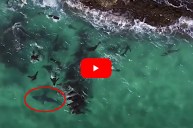Just when you thought it was safe to get back in the water! You know the old spiel, but Long Island Sound swimmers are living their own version of Jaws. Okay, so maybe I'm exaggerating just a little bit. It's not quite blood in the water, mass panic, guy with a fishing hook. Scratch that last one, that might have been I Know What You Did Last Summer. But swimmers are concerned about increased presence of sharks on the Sound.
From the sound of things, biologists are ringing the alarm bell. "They're not right offshore of the beaches, but they can come in pretty close to shore," fisheries biologist Jon Vander Werff told the Hartford Courant.
The Long Island Sound is home to five shark species in total. There's the spiny dogfish, the smooth dogfish, the dusky shark, the brown shark and the sand tiger shark. However, none of these should keep you up at night. The biologist said these sharks aren't aggressive. Likewise, the Long Island Sound has plenty of food for the hungry fish.
"I would say if they were provoked, like, for example, you're swimming and you kick one, they might come around [for] an exploratory bite," he said. Likewise, seasoned diver John Langlois says that the fish get a bad rap in general.
Sharks Are Becoming More Abundant At Long Island Sound
"When you look at how many, they get a bad reputation, because as soon as somebody gets bit, it sounds like hundreds of people are getting bit, but they're not," he said. "And there's so few bites that what makes them so bad of course is the publicity."
However, occasionally one of the big boys makes it way to the Long Island Sound. We're talking about sharks like great whites. Unfortunately, biologists like Vander Werff says the Sound is becoming more hospitable for these larger sharks.
"The water quality is there for them and the ecosystem has been rebounding from years' past, where there hasn't been a lot of sharks," he said. "Some people might not think that's a good thing. But as a fisheries biologist, I look at that as an excellent thing because the ecosystem is rebounding, and now there's enough resources for the sharks to be surviving in Long Island Sound."
Particularly, sand bar sharks are becoming more abundant, according to biologist David Molnar of Connecticut's Department of Energy and Environmental Protection.
"Some of it's their biology. It takes between one and three years to have pups, and they only have a couple of pups when they do pup," he said. "We only see them in the summertime. They're here now; they're popping."




